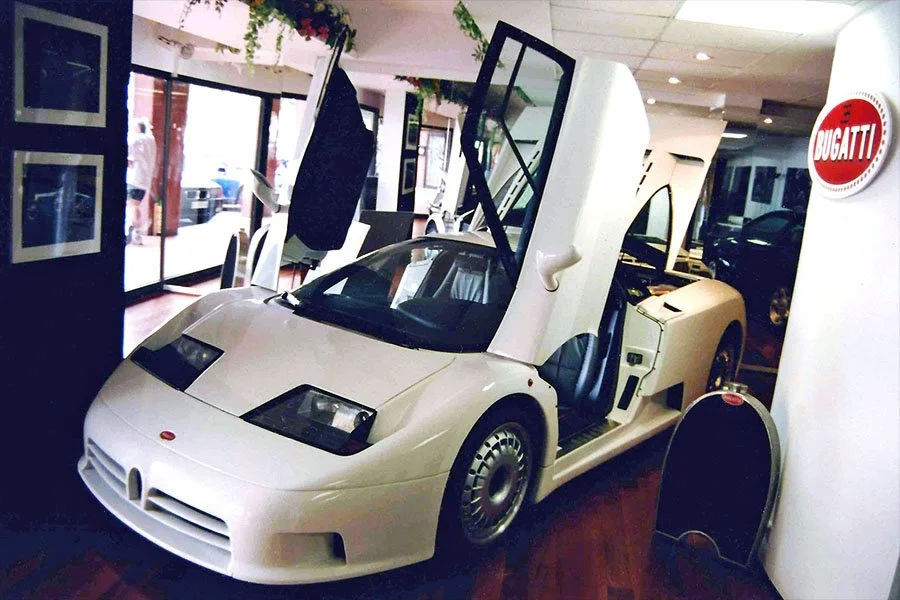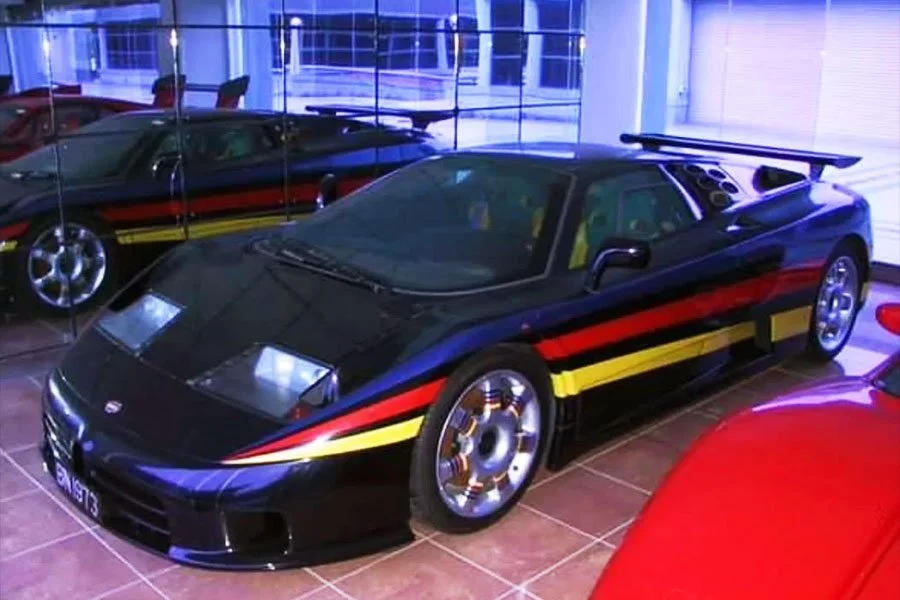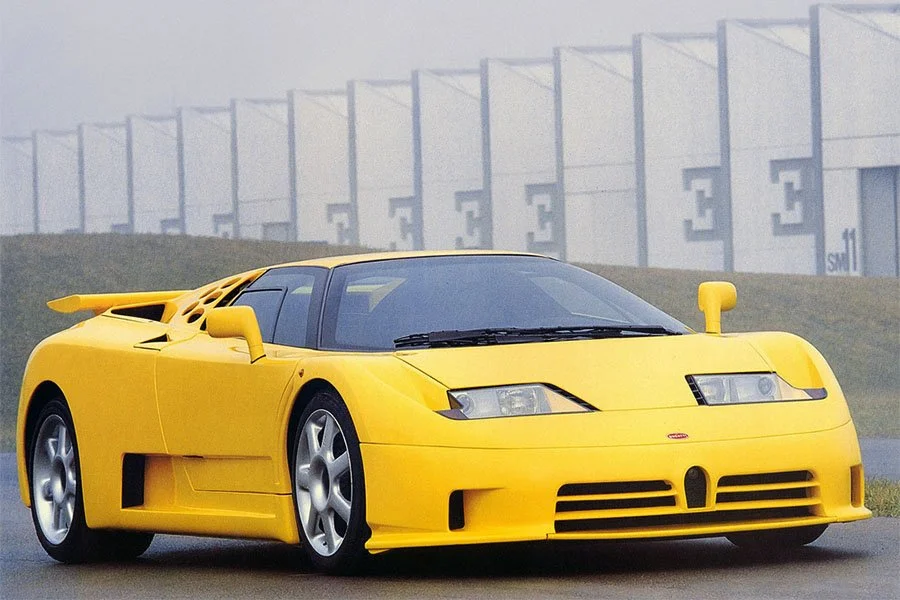Guide: Bugatti 16.4 Veyron Grand Sport - a Historical & Technical Appraisal
/BACKGROUND
After a long and technically challenging six year gestation, Bugatti finally started production of the Veyron in late 2005.
The original plan for a normally-aspirated W18-engined machine was eventually dropped in favour of a quad-turbocharged W16-powered car. Although the Veyron ultimately came in a little heavier than hoped for, all other performance targets were met; the new Bugatti pumped out 987bhp, had a record-breaking 253mph top speed and could his 186mph from a standstill in just 16.7 seconds.
Despite Veyron sales initially having been slower than hoped for, as a response to customer requests, Bugatti added a Roadster version to the line up three years after fixed-head deliveries had begun.
Unveiled at the Pebble Beach Concours d’Elegance in August 2008, the new Veyron Grand Sport was named in recognition of the Type 40 and Type 43 Roadsters from the late 1920s and early 1930s which were arguably the ultimate open top sports cars of their day.
To further publicise the Veyron Grand Sport’s arrival, Bugatti auctioned the first production slot at Pebble Beach achieving a sum of $3.19m.
At the launch, a limited run of 150 units was announced, the first 50 of which were reserved for existing Bugatti customers.
As expected, the Grand Sport was the fastest roadster available at the time.
Production began in June 2009.
CHASSIS
For safety reasons it was necessary to make significant modifications to the Grand Sport's complex structure.
The original Veyron’s roof was an integral part of its design which meant the Grand Sport’s load paths had to be redesigned to maintain rigidity, crash safety and to offer the same protection from a potential side impact or roll over.
To this end, the Grand Sport's monocoque was reinforced around the sills and central tunnel. The doors were made of carbonfibre and housed an integrated longitudinal beam. In the event of an accident, this beam transferred the load from the A to the B-pillar.
Additionally, a reinforced windscreen surround and beefed up air scoops behind the roof offered enhanced protection in the event of a roll.
Aside from a fractionally lower ride height (by 2mm) and re-rated dampers to reflect the Grand Sport’s additional weight, the rest of the chassis, suspension and brake layout was imported direct from the standard Veyron.
The wheelbase stayed at 2710mm. An aluminium front subframe supported the suspension, axle differential, radiator pack, steering system and battery. The rear subframe supported the engine and was once again made from steel in order to cope with the considerable heat given off by the engine.
Also mounted at the back of the monocoque were carbonfibre support bags for the rear suspension. A carbonfibre crossbeam screwed onto the two longitudinal supports and formed the rear edge of the frame structure. The rear periphery of the frame structure consisted of aluminium components that, like the front subframe, were designed to deform in the event of an impact.
Suspension was via double wishbones, coil sprung shock absorbers and anti-roll bars. A hydro-electronic damper control system adjusted the ride height in three stages according to road speed.
Cross-drilled and radially-vented carbonfibre reinforced silicon carbide composite discs were manufactured by SGL Carbon. Aluminium monobloc calipers were sourced from AP Racing and featured titanium pistons.
The front axle employed 400mm brake discs, eight piston calipers and four brake pads. At the back, 380mm discs were installed with six-piston calipers and two pads per side.
An anti-lock brake system was fitted along with a Brake Assist facility that increased pressure on the brake lines during emergency stops.
The Grand Sport came with newly designed 20-inch diameter OZ Racing alloy wheels that measured 10-inches wide at the front and 14-inches wide at the rear.
These were once again shod with specially developed Michelin PAX run-flat tyres, the condition of which was overseen by a continuous pressure monitoring system.
Power-steering offered variable assistance.
A 100-litre fuel tank was located in a cavity at the back of the monocoque.
ENGINE / TRANSMISSION
In the engine bay was the Veyron’s familiar mid longitudinally-mounted W16 engine which was essentially a pair of slender four-litre V8s that shared the same crankshaft. This all-alloy power unit featured dry-sump lubrication, dual overhead camshafts and four valves per cylinder.
It was cooled by nine radiators: three air-to-liquid intercoolers, three engine radiators and one each for the transmission oil, differential oil and engine oil. A tenth radiator served the air-conditioning system.
Four small MP-Engineering MP70 turbochargers were fitted along with a custom engine management system. The compression ratio was 9.0:1.
Displacement was 7993cc thanks to an 86mm bore and stroke.
Peak output was 987bhp at 6000rpm and 922lb-ft at 2200-5500rpm.
A seven-speed direct-shift dual-clutch gearbox was supplied by Ricardo. Gears were shifted either by F1-style paddles behind the steering wheel or a fully automated mode. The dual-clutch set-up meant there was very little interruption in power flow. Gear shifts took just 150 milliseconds.
Transmission was via an electronically-controlled permanent four-wheel drive system that distributed the torque through a front differential with Haldex coupling and a regulated limited-slip differential at the rear. In normal conditions, 30% of the power was sent to the front wheels and 70% to the rear. However, up to 100% could be sent to either axle if required.
The Veyron also came with an ASR traction control system, ESP electronic stability control and a launch control facility. The launch control was employed by pressing a button on the centre console, applying the footbrake, flooring the throttle and then quickly releasing the footbrake.
BODYWORK
The biggest cosmetic difference to the existing Veyron was the Grand Sport’s targa roof configuration.
Bugatti supplied each car with a transparent roof that had to be manually fixed into place.
As there was nowhere for this to be stored when off the car, the Grand Sport also came with a temporary canvas roof.
Headlights with a new design for the daytime running elements were another unique feature.
Otherwise, aside from the beefier engine intake scoops behind the roof, the Grand Sport remained faithful to the original Veyron concept.
Like the fixed head variant, an active aero pack offered three different modes: Standard, Handling and Top Speed.
In Standard Mode the car sat 123mm off the ground and the rear spoiler lay flush with the rear bodywork.
At speeds between 135mph and 230mph, the Veyron automatically switched to Handling Mode (which could also be manually selected at lower speeds via a button on the centre console). Handling Mode dropped the body to 80mm above the tarmac at the front and 95mm at the rear. At the same time, the rear spoiler extended into the airflow and deployed at an angle of between 6° and 26°.
Top Speed Mode was activated by coming to a stop with the engine idling. The driver then had to turn a floor-mounted key to the left of their seat. This had the effect of closing the front diffuser flaps, retracting the rear spoiler to a 2° angle and further reducing ground clearance to 65mm at the front and 70mm at the rear. Once beyond 35mph, should the steering wheel be turned at an angle of 90° or greater, or the brakes be applied, the car automatically reverted back to Handling Mode.
Pressing hard on the brake pedal at high speed had the effect of rapidly tilting the rear spoiler to an angle of 55°. Amazingly, the Veyron was capable of generating up to 2g of deceleration.
In Standard Mode the Grand Sport had a drag coefficient of 0.39 (compared to 0.393 for the fixed head variant). This increased to 0.42 in Handling Mode (compared to 0.417) and dropped to 0.36 in Top Speed Mode (compared to 0.355). With the air brake activated, the drag coefficient was 0.68 (compared to 0.682).
INTERIOR
The cockpit design was unchanged. It mixed art deco styling with the latest technology and was kitted out with a mix of fine leather, highly polished metals and exposed carbonfibre.
Behind the three-spoke steering wheel with its magnesium alloy paddle shifters and control stalks was a curved binnacle with five analogue instruments. In the centre was a large 8000rpm tachometer. To the left was a mid-size engine output gauge calibrated from 0-1001 PS. Above this was a small oil temperature read out. To the right of the rev counter was a mid-size 280mph / 430kmh speedometer with a small fuel gauge above. The three larger gauges also housed digital read outs and an array of warning lights.
The sloping centre console was home to an analogue clock, two fresh air vents, a hazard warning light switch, a Burmester audio system, the climate controls and the gear lever. Alongside the gear lever were switches for the heated seats, launch control, Handling Mode activation and engine start.
OPTIONS
Bugatti offered the new Grand Sport wheels in a choice of three finishes: polished, polished faces or painted.
Specific bodywork sections could be configured in painted, polished or exposed carbonfibre.
Other options included brake calipers in a choice of four colours (blue, yellow, red or black), door handles in body colour or polished aluminium, exterior mirrors in body colour or exposed carbonfibre, mesh grilles in black or Mirrorshine, chrome or black tail pipes and Pierre Veyron or Ettore Bugatti signature script.
For the interior, buyers could select a centre console in either turned aluminium, leather, body colour or exposed carbonfibre. Customised door sill plates were also available.
WEIGHT / PERFORMANCE
As a result of the reinforced monocoque, the Grand Sport tipped the scales at 1990kg which represented a gain of 102kg over the standard Veyron.
With the fixed roof in place, top speed was unaffected: 253mph.
With the roof off, this dropped to 224mph.
If the temporary canvas roof was attached, Bugatti recommended a maximum of 80mph.
The Grand Sport’s 0-62mph time increased from 2.5 seconds to 2.7 seconds.
Acceleration figures for 0-125mph and 0-187mph were unchanged at 7.3 seconds and 16.7 seconds respectively.
SPECIAL EDITIONS
In addition to one off specifications at customer request, Bugatti produced a number of Grand Sport Special Editions between 2009 and 2012.
VEYRON GRAND SPORT SANG BLEU
The first Grand Sport special edition was the Sang Blue which Bugatti unveiled at the Pebble Beach weekend in August 2009.
Created to celebrate Bugatti’s 100th anniversary celebrations, the one-off Sang Bleu (Blue Blood) was the last centenary special. It followed two fixed head variants: the Veyron Bleu Centainaire and Veyron Villa d’Este, one and four of which were produced respectively (covered separately).
The Sang Bleu was arguably the best of the bunch. It mixed special Royal Blue exposed carbonfibre with highly polished doors and front fenders. The wheels were given a two-tone Midnight Blue and diamond cut finish.
The interior was upholstered with newly developed Gaucho leather to include the centre console.
Bugatti reputedly priced the unique Sang Bleu at around $2m before tax.
VEYRON GRAND SPORT SOLEIL DE NUIT
At the Dubai Motor Show in December 2009, Bugatti unveiled three special Edition Veyrons, one of which was based on a Grand Sport.
The Grand Sport Soleil de Nuit (Sun of the Night) was painted Black Blue Metallic with polished aluminium lower sections and matching engine intake scoops. It also came with Mirroshine grilles and Black Blue Metallic Sang Noir wheels with diamond cut faces.
The interior was upholstered in tan leather to include the centre console. Dark blue Soleuil de Nuit script was embroidered into each head rest.
The unique Soleil de Nuit Veyron Grand Sport was originally offered at a pre-tax price of $2.27m.
VEYRON GRAND SPORT L’OR BLANC
One of the most spectacular of all Veyron special editions was the Grand Sport L’Or Blanc unveiled during June 2011 at the Berlin Royal Porcelain Factory (KPM).
The collaboration between KPM and Bugatti resulted in the first car to feature porcelain elements for its bodywork and interior.
By applying a special shade of blue paint by hand to the exterior, it gave the appearance of porcelain elements that flowed over the body in a series of sweeping curves and delicate lines. The bodywork was then covered with five layers of lacquer and fitted with Mirrorshine grilles and aluminium door handles. Red brake calipers were installed along with two-tone dark blue and diamond cut wheels. Porcelain elements were also used on the petrol and oil filler caps.
Inside, the L’Or Blanc was upholstered with a mix of dark blue and white upholstery. Two-tone door panels with porcelain inlays mimicked the exterior. There was a porcelain inlay on the rear panel decorated with Rembrandt Bugatti’s famous dancing elephant.
The one-off Grand Sport L’Or Blanc was originally marketed at a pre-tax price of €1.65m.
VEYRON GRAND SPORT DUBAI MOTOR SHOW SPECIAL EDITIONS
At the Dubai Motor Show in November 2011, Bugatti presented three Grand Sport special editions, each of which was completed to a unique specification.
The first was painted yellow with black visible carbon lower body sections and black wheels. The interior was mostly yellow leather with black stitching except for the upper dash, steering wheel and gear lever which used black leather with yellow stitching. The door panels and centre console were given black visible carbon inserts. This car was priced at €1.58m before tax.
The second example was finished with blue visible carbon upper bodywork and polished aluminium lower sections. The wheels were polished aluminium with diamond cut faces and Mirrorshine grilles were fitted. The interior was Tangerine leather with Indigo stitching except for the upper dash, steering wheel and gear lever which were Indigo with Tangerine stitching. The door panels and centre console were given Indigo blue visible carbon inserts. This car was priced at €1.74m before tax.
The last of the Dubai Motor Show special editions came with green visible carbonfibre that contrasted with polished aluminium doors, front fenders, exterior mirrors and upper front bumper corners. The wheels were also given a matching polished aluminium finish. The interior was as per the second Dubai special edition with a mix of silver and green leather, contrast stitching and green visible carbon inserts. The price was €1.74m pre tax.
VEYRON GRAND SPORT BERNAR VENET
The last Grand Sport special edition was a unique collaboration with French artist, Bernar Venet.
Unveiled at the Rubell Family Collection at Art Basel Miami Beach in December 2012, it was inspired by Venet’s passion for mathematical formulas and scientific theories.
Rust coloured technical equations used to calculate the power of the Veyron’s engine were stencilled on to the front of the Grand Sport’s otherwise dark brown body. The front wheels were a mix of rust inlays with diamond cut faces. Those at the rear used body coloured dark brown inlays with diamond cut faces. Black grilles were used throughout.
The interior was a mix of dark brown and dark tan leather with rust coloured formulas embroidered into the door inserts.
No price was ever quoted for this spectacular Bugatti Art Car.
END OF PRODUCTION
Grand Sport production ended in 2015, by which time 158 cars had been completed, all of which were left-hand drive.
Text copyright: Supercar Nostalgia
Photo copyright: Bugatti - https://www.bugatti.com



























































